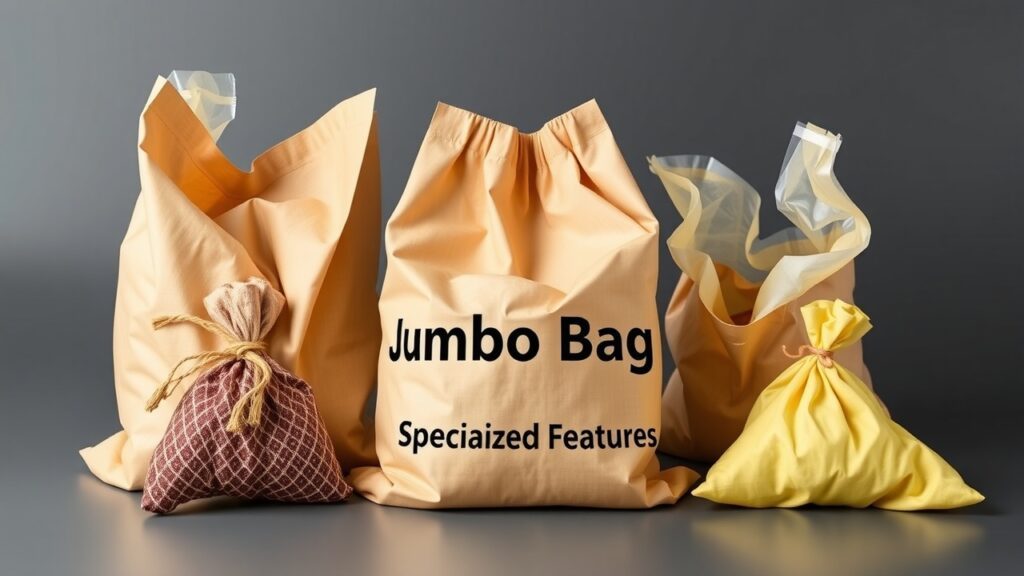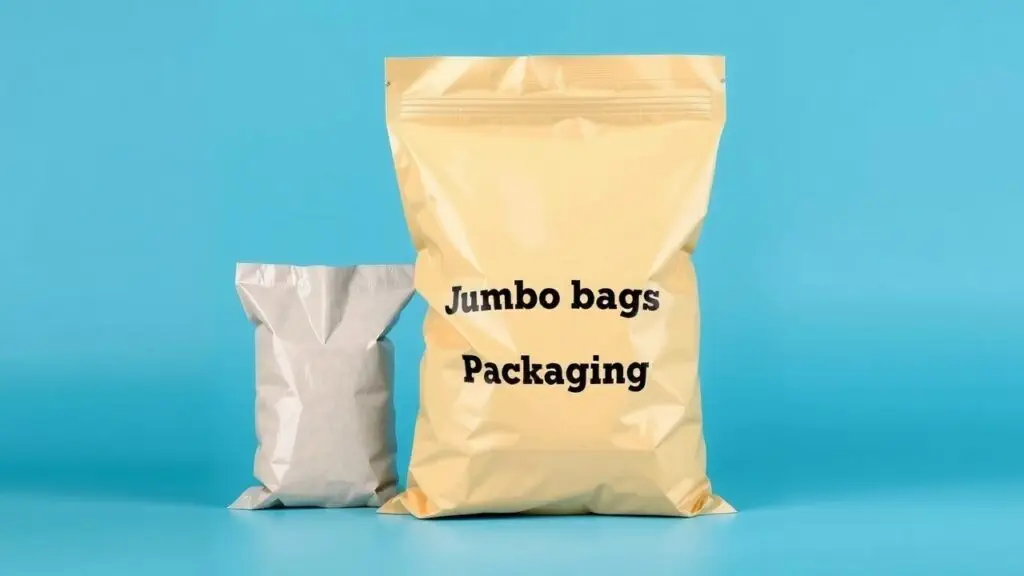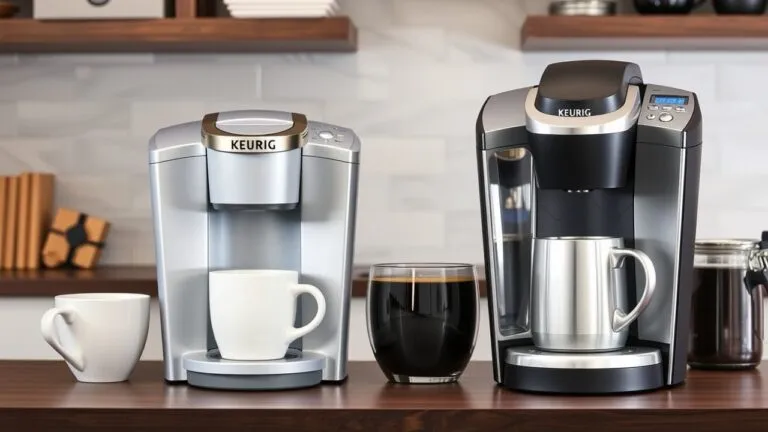Discover the different types of jumbo bags. Choosing the right jumbo bag for bulk storage is key. This guide explains the differences between U-panel, circular, and 4-panel jumbo bags, considering factors like size and material to find the perfect fit for your application.
What are Jumbo Bags (FIBCs)?

Jumbo bags are also known as Flexible Intermediate Bulk Containers (FIBCs). You might hear them called super sacks or bulk bags, too. These large containers are made for storing and transporting bulk materials. They can hold various products, including grains, chemicals, and construction materials. Most jumbo bags are made from woven polypropylene fabric. They come in different sizes and designs to fit various goods.
The design of these bags allows them to carry heavy loads—often up to 2 tons. This makes them a smart choice for businesses dealing with large quantities of materials. They often have lifting loops for easy handling and discharge spouts for quick unloading. Because of these features, jumbo bags are popular in logistics and supply chain management.
Benefits of Using Jumbo Bags
Using jumbo bags comes with many benefits:
- Cost-Effective Storage: They cost less than traditional packaging like drums or boxes because they are lighter.
- Efficient Storage: Their stackable design helps save space in warehouses and reduces shipping costs by fitting more products per shipment.
- Safety Advantages: Many modern FIBC designs include safety features like anti-static properties or UN certification for transporting hazardous materials. This keeps workers safe and ensures compliance with regulations.
These benefits make jumbo bags a great choice for many industries looking to improve their operations while keeping quality high.
Types of Jumbo Bags Overview
There are several types of jumbo bags you can find today:
- Woven Polypropylene Bags: These are the most common type used for general purposes because they are strong and resist moisture.
- Laminated Jumbo Bags: They have an extra layer that gives added protection against water and dust contamination.
- Conductive Jumbo Bags: These special bags are made to safely transport electronic parts by preventing static electricity build-up.
- UN-Certified Jumbo Bags: These bags can carry hazardous materials and meet strict international safety standards.
Knowing about the different types helps businesses choose the right bag for their needs based on the kind of material they will store or transport.
Woven Polypropylene Jumbo Bags
Woven polypropylene jumbo bags, often called bulk bags or flexible intermediate bulk containers (FIBCs), are very important in many industries. These industrial bags are made from woven polypropylene fabric. This fabric is strong, durable, and flexible, making it perfect for transporting and storing materials.
Construction and Materials
The way woven polypropylene jumbo bags are built is key to how well they work. They mainly use polypropylene fabric, which is light but very strong. The weaving process helps the bags distribute their load evenly while keeping the seams intact.
Different stitch types are used in making these bags. Lock stitching is popular because it creates strong seams that don’t easily break or fray, even with heavy loads. There are also different weave patterns, like plain and leno. These patterns can affect both the bag’s look and its performance.
Weave Pattern Examples:
- Plain: Basic strength through simple interlacing.
- Leno: More airflow; great for certain storage needs.
Detailed Explanation of Woven Polypropylene Fabric
Woven polypropylene fabric has special properties that make it useful in many applications. It’s resistant to moisture, chemicals, and UV rays, which helps it last a long time even in tough conditions. Plus, it’s flexible enough to shape around different items when being stored or moved.
Lock stitching plays a big part in making sure seams hold up under pressure. Other types of stitches might be used for specific jobs but generally aim to boost durability while keeping costs down.
Weave patterns like plain offer solid support, while leno allows air to flow through—important when storing materials that can get damp.
Impact of Weave on Strength and Breathability
The weave type has a big effect on the strength and breathability of woven polypropylene jumbo bags. A tighter weave usually gives better tensile strength. This means the bag can hold heavier items without tearing or losing shape over time.
On the other hand, a looser weave increases airflow inside the bag but might weaken it a bit. Finding the right balance between strength and breathability is important based on what will be stored inside. For example, breathable designs work well for moisture-sensitive products, while stronger builds are better for heavy materials.
So, understanding how different weaves impact these features can help users choose the right bag type for their needs—whether they need support for heavy items or ventilation for delicate goods.
Applications
Woven polypropylene jumbo bags have lots of uses across various sectors.
Common Applications:
- Agriculture: Storing grains or other crops.
- Construction: Transporting sand, gravel, or soil.
- Chemical Handling: Safely managing hazardous materials.
Specific Uses in Various Industries
In agriculture, these bags are great for grain storage because they keep contents dry and safe from pests. In construction, they easily move sand or gravel from one site to another. Plus, they meet strict chemical handling requirements, ensuring safety during transport.
Pros & Cons
When considering woven polypropylene jumbo bags, it’s good to weigh their pros and cons.
Cost Analysis
They offer cost-effective storage options compared to other packaging choices. Their ability to hold large quantities reduces overall costs over time.
Durability
These bags are tough and can handle harsh weather and rough handling without falling apart quickly.
Moisture Resistance
They work well for storing materials sensitive to moisture since they’re designed to keep contents dry.
Suitability for Different Materials
These bags can hold various products like powders or granules effectively without leaking or tearing.
Overall, woven polypropylene jumbo bags provide strong solutions for storage and transport needs across many industries!
Laminated Jumbo Bags
Laminated jumbo bags, also called flexible intermediate bulk containers (FIBCs), are made for storing bulk materials safely. These bags are built using a lamination process that gives them a strong moisture barrier. This makes them perfect for different industries that need dependable packaging solutions. They work well for food-grade products, chemical storage, and pharmaceuticals.
Construction and Materials
Laminated jumbo bags are made from several layers of materials, which add to their strength and usefulness. The lamination process usually has an outer layer of woven polypropylene (PP) fabric, plus an inner liner. The most common inner liner materials are polyethylene (PE) and high-density polyethylene (HDPE).
These liners boost moisture resistance and improve barrier properties. They keep the contents dry and free from contamination during storage or transport. Choosing between PE and HDPE liners often depends on the specific needs of the product being stored. For instance, HDPE is stronger but can be less flexible than PE.
Applications
Laminated jumbo bags are widely used in various industries where keeping products safe from moisture or contamination is important:
- Food Industry: They store grains, flour, sugar, and more while meeting safety rules.
- Pharmaceuticals: These bags package active ingredients or finished products to avoid contamination.
- Chemical Storage: They’re good for holding chemicals that need secure containment against outside factors.
These examples show how versatile laminated jumbo bags are for bulk storage needs across different sectors.
Pros & Cons
When thinking about laminated jumbo bags as affordable options for storing liquids and powders, it’s wise to look at both benefits and drawbacks:
Pros:
- Great moisture barrier keeps sensitive materials safe.
- Available in many sizes to fit specific needs.
- Strong construction works well for heavy-duty use.
Cons:
- There’s a chance of liner damage during transport or handling if not careful.
- They may cost more initially than regular non-laminated options due to their special manufacturing process.
In summary, laminated jumbo bags provide strong packaging solutions for many sectors needing protection against moisture while balancing cost with performance.
Conductive Jumbo Bags
Conductive jumbo bags, or static dissipative FIBC bags, are specially made to manage materials that can create static electricity. They are crucial for industries where flammable or explosive materials need safe transport or storage.
Construction and Materials
These bags are made from woven polypropylene fabric that has conductive properties. The main feature of conductive jumbo bags is their ability to lower static electricity by using conductive yarns woven into the fabric. This special design helps safely handle and transport sensitive materials.
Many of these bags also get an anti-static treatment during production. This treatment makes sure the bag can let go of any static charge that builds up. It makes them ideal for places where electrostatic discharge could cause danger.
Applications
Industries needing protection from static rely heavily on conductive jumbo bags. Important sectors include:
- Chemicals
- Pharmaceuticals
- Electronics
These fields have high risks, where even a small spark can ignite flammable substances or harm delicate parts.
Common uses for these bulk containers include transporting powders like plastics and chemicals. These powders can create dust that might spark if not handled carefully. By using conductive jumbo bags, businesses reduce the risks related to static electricity during storage and transport.
Pros & Cons
The main benefits of conductive jumbo bags relate to safety compliance. They offer better protection against fire risks due to their design which prevents electrostatic discharge. This makes handling dangerous materials safer.
However, there are some downsides. One key issue is the potential higher cost compared to non-conductive options. While they provide significant safety advantages, companies need to balance this cost against their needs and budget when choosing packaging for bulk materials.
UN-Certified Jumbo Bags
UN-certified jumbo bags are a must for transporting hazardous materials safely. These bags follow strict safety compliance rules, keeping the contents secure during transit and storage. They go through rigorous testing requirements to prevent leaks and spills. This makes them a trustworthy choice for businesses that handle dangerous substances.
UN Certification
For jumbo bags to earn UN certification, they need to meet specific UN standards for transporting hazardous materials. This means they must pass testing requirements that check their strength and durability under pressure. Each bag gets marked according to FIBC (Flexible Intermediate Bulk Container) regulations. This shows they can carry certain types of goods safely. The certification involves drop tests and stacking tests, ensuring the bags hold up in real-world conditions without risking safety.
Applications
UN-certified jumbo bags serve many important purposes where safety is key:
- Transporting Hazardous Materials: These bags follow rules for moving chemicals and other dangerous goods.
- Chemical Storage: They offer a safe way to store various chemicals while reducing risks of leaks or contamination.
- Food-Grade Jumbo Bags: Some bags are designed for food products, following health regulations while keeping the product safe.
Pros & Cons
Using UN-certified jumbo bags comes with several benefits and drawbacks:
Pros:
- Safety Compliance: Meeting international standards helps keep hazardous materials safer during transport.
- Rigorous Testing Requirements: Knowing the packaging has been thoroughly tested brings peace of mind.
Cons:
- Cost Considerations: The price of UN-certified bags can be higher than regular options due to extra testing and certification steps.
- Complex Regulations: Figuring out which bag fits specific regulatory needs can be tricky without expert help.
Choosing the right jumbo bag is very important when dealing with bulk materials, especially hazardous ones. It helps ensure safety while managing costs and keeping operations running smoothly.
Jumbo Bags with Specialized Features
Baffles
Baffle bulk bags are made to keep their shape and stay stable when filled. They have special internal baffles that prevent bulging. This helps improve stacking efficiency, which is great for saving space. With better load distribution, these bags reduce the chances of damaging products during transport.
Discharge Spouts
Discharge spouts are key features in jumbo bags that make emptying contents easy and quick. You can find these spouts in different designs, like bottom options, allowing for smooth discharge without needing extra help. Some bags also come with filling ports to streamline the process from filling to unloading. Choosing the right discharge spout can boost your operational efficiency.
Lifting Loops
Lifting loops are important parts of jumbo bags that help in safely handling heavy items. There are usually two types: one loop big bags and two loop big bags. Each type has its own weight capacity to fit different uses. One-loop designs are simple, while two-loop models offer better stability when lifting.
Other Features
Jumbo bags can have many customizable options based on your needs:
- UV Protection: Useful for outdoor storage or transport where sunlight could damage the bag.
- Tamper Evidence: Important for keeping food safe or protecting sensitive materials; it shows if the bag was opened before.
- Top Closure Options: Different designs like spout tops, duffle tops, or open tops give you choices for filling and sealing the bag.
- Bottom Configurations: Options like flat bottoms or conical bottoms meet various loading needs.
These specialized features make jumbo bags versatile for different industries, such as agriculture, chemicals, and construction. Customization enhances performance to meet user requirements effectively.
Choosing the Right Jumbo Bag: A Selection Guide

Factors to Consider
When picking a jumbo bag, you should think about a few key points. First, consider the material compatibility; this ensures that the bag matches what you’re storing. Next, handling requirements are important, especially if workers will be lifting these bags. Storage conditions matter too—where and how the bags will be kept affects their choice. Don’t forget to check weight capacity and understand the applications of jumbo bags in your industry. Also, keep in mind any environmental conditions like temperature and humidity. Lastly, make sure to align your choice with any regulatory requirements that might apply, along with your budget.
Material Properties
Most jumbo bags are made from woven polypropylene (PP). This material is strong and durable. You might also find laminated jumbo bags, which offer extra protection against moisture. Conductive FIBC bags are another option. These are perfect for sensitive materials like electronics or flammable substances. Choosing the right material affects how well the bag performs.
Environmental Conditions
You need to consider environmental factors when selecting a jumbo bag:
- UV Resistance: Some materials can withstand sunlight better than others.
- Chemical Resistance: Knowing what chemicals may contact the bag is key.
- Moisture Sensitivity: If moisture is a concern, look for laminated bags that keep humidity out.
Budget Considerations
Finding cost-effective storage solutions is possible with many suppliers and manufacturers offering various types of jumbo bags at different prices. While budgeting for these bags, remember to think about not just the upfront costs but also their durability and potential for reuse over time.
Material Compatibility
Knowing what materials work well with each type of jumbo bag is vital. For example, if you’re storing powders or granular items, using a compatible materials chart can help identify which features you need in your bag. This prevents issues like contamination during transport.
Size and Capacity
Selecting the right size for your needs involves understanding both volume measurements and weight limits:
- Jumbo Bag Sizes: Sizes often range from 500 kg up to 2000 kg.
- Weight Capacity: It’s crucial that the bag can handle its contents without risk during lifting or moving.
- Calculating Appropriate Size Based on Volume and Weight: To figure out the correct size based on volume:
- Measure product dimensions (length x width x height).
- Calculate total cubic meters needed by multiplying those numbers together.
- Compare this total with standard sizes offered by manufacturers.
Best Practices and Safety Procedures
Safe Handling Procedures
When using jumbo bags, or flexible intermediate bulk containers (FIBCs), it’s super important to follow safety guidelines. This keeps everyone safe and helps everything run smoothly. Here are some key practices:
- Inspect Before Use: Check each bag for damage. Look for tears or holes, especially in the lifting loops.
- Use Correct Lifting Techniques: Train all workers on proper lifting methods. Make sure they lift only using the designated loops and do not go over weight limits.
- Know the Right Discharge Methods: Different materials need different ways to unload them. Learn how to do this to avoid spills or contamination.
- Work in a Clean Environment: Keep the area around jumbo bags clear of sharp objects that could cause damage.
By following these FIBC bag handling guidelines, you can reduce risks in bulk material handling and keep your operations efficient.
Safety Features
Jumbo bags have several safety features that help protect users and contents during storage and transport:
- Reinforced Lifting Loops: These loops add strength and stability for heavy loads.
- Anti-static Materials: Some bags are made with materials that reduce static electricity, which is great for flammable products.
- UV Protection: If bags are stored outside, UV-resistant fabrics help prevent damage from sunlight.
Knowing these safety features helps you choose the right industrial packaging solutions while sticking to safety standards.
Disposal Guidelines
Properly disposing of used jumbo bags is key for safety and protecting our environment:
- Identify Bag Material: Know what material makes up your bag—most are polypropylene (PP) woven fabric, which is often recyclable.
- Look Into Recycling Options: Many areas have recycling programs just for industrial packaging waste; find out what’s available near you.
- Follow Responsible Practices: Stick to disposal guidelines from manufacturers about how to handle different types of jumbo bag materials.
Having good disposal methods helps industries move toward more sustainable practices when using bulk storage solutions.
Frequently Asked Questions about Jumbo Bags
What types of materials can I store in jumbo bags?
Jumbo bags can store various materials, including grains, chemicals, and powders. They are suitable for both dry flowable products and bulk solids.
How do I choose the right size for my jumbo bag?
To select the right size, consider the product’s volume and weight. Measure the dimensions of your material and compare it to standard bag sizes.
What are the benefits of using UN-certified jumbo bags?
UN-certified bags meet safety regulations for hazardous materials. They ensure secure transport and help prevent leaks or spills during handling.
Can I customize my jumbo bags?
Yes, you can customize jumbo bags. Options include printing logos, selecting colors, or adding specific features like liners and discharge spouts.
Are laminated jumbo bags suitable for food storage?
Yes, laminated jumbo bags provide excellent moisture protection. They meet food safety standards, making them ideal for storing grains and powders.
What is the difference between conductive and anti-static jumbo bags?
Conductive bags reduce static electricity by dissipating charges. Anti-static bags prevent static buildup but may not be as effective in high-risk environments.
How do I maintain my jumbo bags?
Regularly inspect your bags for damage. Store them away from sharp objects and avoid overloading to ensure their longevity.
Types of Jumbo Bags
- U-Panel Bags: Ideal for stable stacking.
- Quad-Panel Bags: Great for heavy loads.
- Circular Bags: Best for even load distribution.
- Discharge Spout Bags: Allow easy unloading.
- Open Top Bags: Simple filling process.
- Customized Jumbo Bags: Tailored to specific needs.
- Food-Grade Jumbo Bags: Safe for food storage.
- Heavy-Duty Jumbo Bags: Designed for tough applications.
Bag Features
- Liners: Used to enhance moisture resistance.
- Discharge Ports: Improve unloading efficiency.
- Lifting Loops: Facilitate safe handling.
By understanding these aspects, you can make informed choices about different types of jumbo bags suitable for your operations.
Related Topics
- types of woven polypropylene bags
- types of laminated jumbo bags
- types of UN-certified jumbo bags
- types of jumbo bag features
- types of jumbo bag closures
- types of jumbo bag bottoms
- types of jumbo bag lifting loops
- types of jumbo bag liners
- types of jumbo bag applications



Types of Jumbo Bags: U-Panel, Circular, 4-Panel, and More for Bulk Storage